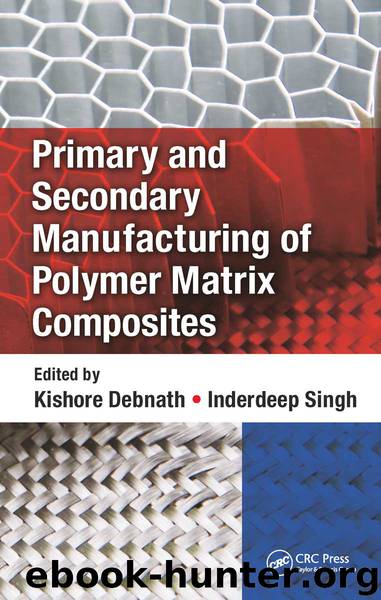Primary and Secondary Manufacturing of Polymer Matrix Composites by Kishore Debnath Inderdeep Singh

Author:Kishore Debnath,Inderdeep Singh
Language: eng
Format: epub
Publisher: CRC Press LLC
FIGURE 6.5 Dye-penetration technique: (a) test specimen with defects, (b) test specimen dipped in the fluorescent liquid, (c) removal of excess penetrant and (d) application of developer to identify the invisible cracks.
6.8 RADIOGRAPHY TESTING
Radiography testing is a non-destructive testing method to characterise the internal structure and presence of flaws in the polymer-based composite material. In this method, electromagnetic radiation of X-rays and neutrons are used to examine the internal structure and defects in the composite materials. Many authors carried out X-ray radiography testing in their study to evaluate the structure of the developed polymer composite and to identify the presence of defects and flaws in the geometry of the composite material. Prade et al. (2017) characterised the fibre orientation in GF-reinforced polymer and CF-reinforced polymer composites using X-ray radiography. The authors concluded that X-ray radiography-testing method does not restrict the size of the test specimen and allows for very shorter measurement. Schilling et al. (2005) investigated the internal flaws of S-glass/epoxy and graphite/epoxy composite using X-ray micro-tomography. The authors concluded that X-ray micro-tomography can clearly identify the internal flaws such as matrix cracking, fibre fracture and so on in the fibre-reinforced polymer composite. The X-ray radiography-testing method is discussed in the following section in detail.
Download
This site does not store any files on its server. We only index and link to content provided by other sites. Please contact the content providers to delete copyright contents if any and email us, we'll remove relevant links or contents immediately.
| Automotive | Engineering |
| Transportation |
Whiskies Galore by Ian Buxton(41537)
Introduction to Aircraft Design (Cambridge Aerospace Series) by John P. Fielding(32893)
Small Unmanned Fixed-wing Aircraft Design by Andrew J. Keane Andras Sobester James P. Scanlan & András Sóbester & James P. Scanlan(32579)
Craft Beer for the Homebrewer by Michael Agnew(17938)
Turbulence by E. J. Noyes(7708)
The Complete Stick Figure Physics Tutorials by Allen Sarah(7148)
Kaplan MCAT General Chemistry Review by Kaplan(6603)
The Thirst by Nesbo Jo(6444)
Bad Blood by John Carreyrou(6283)
Modelling of Convective Heat and Mass Transfer in Rotating Flows by Igor V. Shevchuk(6230)
Learning SQL by Alan Beaulieu(6041)
Weapons of Math Destruction by Cathy O'Neil(5842)
Man-made Catastrophes and Risk Information Concealment by Dmitry Chernov & Didier Sornette(5659)
Digital Minimalism by Cal Newport;(5396)
Life 3.0: Being Human in the Age of Artificial Intelligence by Tegmark Max(5193)
iGen by Jean M. Twenge(5166)
Secrets of Antigravity Propulsion: Tesla, UFOs, and Classified Aerospace Technology by Ph.D. Paul A. Laviolette(5002)
Design of Trajectory Optimization Approach for Space Maneuver Vehicle Skip Entry Problems by Runqi Chai & Al Savvaris & Antonios Tsourdos & Senchun Chai(4847)
Electronic Devices & Circuits by Jacob Millman & Christos C. Halkias(4752)
